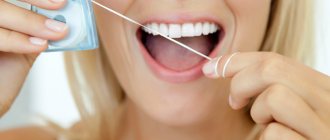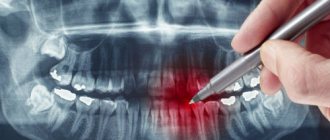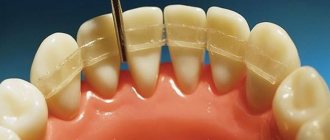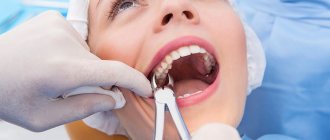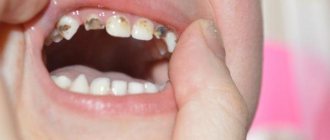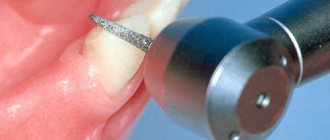People turn to the dentist when they have any problems with the health of their teeth or gums. Pain in the tooth, swelling of the gums, increased sensitivity of the teeth, bad breath - all these phenomena can appear against the background of various dental diseases and, based on the nature of the disease, the specialist selects the optimal method of dental treatment.
Whatever method of dental treatment is chosen, its main task will be to preserve all the functions and aesthetics of the tooth. Below we will look at a variety of dental treatment methods that are used in modern dentistry and will also talk about complications that can occur when errors in treatment procedures were made by the doctor.
Caries: features, symptoms
According to statistics, at least 95% of people in the world have encountered caries at least once. This is the most common dental disease that affects people regardless of gender, age and lifestyle.
Caries belongs to the list of pathological processes. Initially, it begins to destroy the enamel, but if left untreated, it also affects the deep hard layers of tooth tissue. When soft tissue inflammation begins, blood vessels and nerves are inevitably also affected.
Patients often wonder whether tooth decay needs to be treated. In fact, it is necessary not only to engage in prevention, but also to begin treatment as soon as possible. If the disease is neglected, there is a high risk of losing the tooth completely.
Compulsory medical insurance or VHI
If voluntary health insurance is not offered by your employer, then applying for it yourself does not make much sense. In this situation, it is more profitable to be treated under compulsory medical insurance, choosing clinics based on reviews on the Internet or word of mouth. In order to be treated by a doctor you like in a public clinic, you need to detach yourself from the one to whom you are assigned at your place of residence.
Many are treated in government clinics and are friends with doctors. You come and the doctor performs some manipulations on you under the compulsory medical insurance policy, but at the same time you receive high-quality treatment. Roughly speaking, a filling costs 3 thousand. You pay 1–1.5 thousand into his pocket, and the rest goes according to the policy. And it will be more profitable than going under the VHI program
VHI, if it is paid for by the employer, is beneficial to use for preventive examinations, research, tests, to get general advice, to do high-quality teeth cleaning, which is provided in a greatly reduced version under compulsory medical insurance.
Both under compulsory medical insurance and under VHI, you need to be prepared to pay extra and directly ask the doctor what he would recommend for better treatment.
Also, if you have a VHI policy, you need to know what services are included in your specific insurance so that the doctor does not deceive you. For example, he may say that your tariff does not include consultations, although this is not true. In addition, it is better to choose a clinic and a doctor that have proven themselves well in advance, based on reviews and recommendations. In this case, if the doctor tells you that the materials for treatment are not of very high quality, you will have more reason to trust his words.
There are several categories of causes of caries in humans.
The answer to the question of how to treat dental caries depends on the cause of such a disease. It is also very important to eliminate potential conditions for the development of tooth decay.
There are several reasons that can stimulate the appearance of damage to enamel and soft tissues:
- Severe bacterial plaque. It occurs when a person does not properly care for his teeth. It is very important to maintain regular oral hygiene, brush your teeth properly, and use floss.
- Tartar. It can also form if the patient does not comply with the rules of oral hygiene. If the stone is not removed in a timely manner, the lesion will constantly progress and spread.
- Poor nutrition. Risk factors include consuming large amounts of sweet and sour foods. Also on the list of dangerous foods are foods high in carbohydrates and starch. When consuming a large amount of low-quality and unhealthy food, tooth enamel gradually begins to become thinner. Because of this, under the influence of bacteria, the risk of caries becomes increasingly noticeable.
- Decreased saliva production. Under normal conditions, a person produces up to two liters of saliva per day. It is necessary so that food debris can be washed off the surface of the tooth. When the salivary glands do not function properly, these residues remain and the risk of bacterial growth increases.
- Lack of minerals in food. The human body either does not produce many useful substances that are needed to strengthen bones and tooth enamel, or receives them in small quantities. The list of main substances that must be obtained from foods includes fluorine, calcium, and phosphorus. At the same time, genetics also leads to problems for some people. Some people are simply genetically predisposed to accumulate a minimum of nutrients.
- Pregnancy. At different stages, there is a possibility that the fetus takes a lot of useful substances from the mother. She begins to experience a severe lack of minerals.
- Diseases of the body. Patients with systemic pathologies that directly affect metabolic processes are also at risk. Particularly dangerous are variants of diseases such as lesions of the thyroid gland, peptic ulcers, diabetes mellitus, gastritis, and imbalance of hormones in the body.
Another factor in the development of caries is the poor environmental situation in a person’s place of residence. It can stimulate the development of caries, rapid damage to both hard and soft tissues.
For this reason, a high incidence of caries is observed in regions where there are a lot of acids, heavy metal salts, and alkali vapors scattered in the air.
In order to develop a treatment method in a certain situation, it is necessary to understand what reason for the development of the disease is relevant in the case of a particular patient.
The fact is that often it is chronic diseases, improper oral hygiene, and lack of nutrients that can trigger the recurrence of the disease. In any situation, it is very important to eliminate the cause itself.
Causes of dental problems
The occurrence of a problem such as caries is associated with the destructive effect of bacteria on the structure of the teeth. The microflora in the oral cavity includes a huge number of microorganisms. Even proper and thorough brushing of teeth with special means and the use of rinses cannot make the oral cavity completely sterile. The proliferation of pathogenic bacteria begins 2-4 hours after the last cleaning.
What exact reasons can cause tooth damage?
- poor oral care;
- unbalanced diet;
- decline in immunity;
- gastrointestinal diseases;
- avitaminosis;
- insufficient amount of minerals (calcium, fluorine) in drinking water.
Main types of caries
How caries is treated in dentistry largely depends on which type of spread is typical for a particular person. There are several classification criteria:
- Spread intensity. This category includes single and systemic caries. The difference is that in the first case, the patient is not diagnosed with any additional symptoms. In the second case, the entire row or most of it is also affected. The constant spread of new lesions not only stimulates damage to the enamel and soft tissues, but also impairs the functioning of the human immune system.
- Complexity of development. Uncomplicated caries is the easiest to treat. In this case, there are no additional disorders that lead to the need for additional surgical intervention. Complicated caries is a situation that is accompanied by periodontitis and pulpitis. In this case, treatment must be much longer and more difficult.
In our clinic, doctors treat caries regardless of the stage of the process. We are ready to deal with a problem when there is one of the following four stages:
- Spot. In this case, only the enamel is affected. At the same time, there are spots on the surface with a dark or pale tint. Some people develop stripes instead of spots that are a different color from the rest of the surface.
- Initial surface position. The spot begins to gradually grow, and a hole develops. Sensitivity also increases.
- Middle stage of caries. Dentin begins to deteriorate and pain worsens.
- Deep defeat. Active necrotic damage to hard and soft tissues begins, nerve endings and blood vessels are affected. Treatment in this case will be much more complex and lengthy.
There is also another classification factor - the location and depth of tooth damage. There are five main classes:
- First. It is characterized by damage to the enamel. At the same time, at the first stage it will be very difficult to understand whether there is a lesion, because visually caries shows little of itself.
- Second. Most often it appears on chewing molars, as well as premolars, regardless of the jaw.
- Third. Found on canines and incisors. Most often, the problem is due to the fact that a person eats a lot of sweets.
- Fourth. Characterized by significant destruction of enamel.
- Fifth. The most severe type of flow option. In this case, caries can affect the entire row of teeth, manifesting itself closer to the gums, near the root - where it is very difficult to cure.
Anesthesia
Conventional local anesthesia is performed very often today. Patients with increased sensitivity of soft tissues and children can first be given topical anesthesia. Also in dentistry, painkillers are used for dental treatment. The type of drug and its dosage are selected individually - it all depends on both the patient’s health condition and the clinical situation. For example, pediatric dentists often treat teeth with nitrogen. Laughing gas causes a feeling of mild euphoria and is not hazardous to health. The patient relaxes, and the doctor can calmly perform all the necessary manipulations. But general anesthesia in dentistry is used only in the most extreme cases.
Anesthesia after dental treatment can last up to 3 – 4 hours. Everything here is very individual and depends on how much anesthetic was used.
Main signs of caries
Often, patients simply do not realize that they have tooth decay because they expect significant enamel damage, severe pain, or other common signs. But the best solution would be to contact our dentists in a timely manner for a thorough external examination.
There are several most common signs that a person is developing tooth decay:
- Change in enamel color. It can change color a lot. Stripes or dots of a dark or light shade appear. At this stage there may be no increased sensitivity or significant pain.
- Increased tooth sensitivity. It appears when eating hot and cold food, pressing, chewing, in the case of sweet or sour foods.
- Severe damage to the enamel. It is immediately noticeable by black holes in the teeth and partial destruction of the enamel.
- Pain. It can be of a different nature, either acute or long-lasting, aching. Depending on the type of problem, it either gets worse when pressing on the tooth or gets smaller.
- Bad breath. Occurs due to significant necrotic tissue damage.
Also, other manifestations are characteristic of the later stages of the disease - headaches, a feeling of shooting pain in the ears. For some, the inflammatory process stimulates fever, general weakness and decreased immunity.
Inflammation of the dental nerve and hard tissues of the tooth
The dental nerve (pulp) is located in the internal cavity of the tooth and contributes to the development and strengthening of the hard tissues of the tooth. Any impact, mechanical or due to infection, can cause inflammation of the nerve. In the acute stage, pulpitis is accompanied by severe pain in the tooth, especially at night. Chronic pathology does not have pronounced symptoms, pain syndrome appears periodically.
Therapy depends on the degree of damage to the pulp tissue. If the inflammation is minor, the dentist fixes the drug in the tooth. Until the disease is completely eliminated. The tooth is then filled. If the dental nerve is completely affected, the pulp is first removed under anesthesia. The dental treatment procedure includes cleaning and filling the canals. Then restoration of the upper, crown part of the tooth.
An advanced form of pulpitis provokes the development of periodontitis – inflammation of the upper part of the tooth root. The main symptoms are sharp pain when pressing on the tooth, swelling of the adjacent gums. It also occurs in acute and chronic stages. Therapy includes the procedure of depulpation and subsequent filling of the canals. If a cyst is present, in some cases an incision is made in the gum and the affected apex of the tooth root is resected.
Potential consequences and complications
The very question of whether caries should be treated is very dangerous. It is important to never doubt that treatment is necessary. Often a person observes the first symptoms of a problem, but begins to put off going to the dentist. The time for treatment is constantly being delayed more and more.
The main danger of this approach is the likelihood of complications. The most common among them is the appearance of periodontitis or pulpitis.
There are several of the most serious consequences of untreated caries:
- Tooth loss. If the tooth is severely damaged or the lesion has gone very deep, there is nothing left except surgical intervention.
- Pathological processes in the gums. They can lead to the need to remove not only the affected tooth, but also its completely healthy neighbors.
- Systemic complications in the functioning of internal organs. The gastrointestinal tract and immune system suffer greatly. It is important to understand that a sluggish inflammatory process has a sharp negative effect on the entire body and weakens it.
The question of how caries is treated in dentistry in children is always considered separately. It is necessary to solve the problem that has arisen with baby teeth, because advanced disease leads to pathologies in the formation of permanent dentition.
Indications for removal
In some circumstances, removing the “eight” becomes the only way out. In particular, the doctor will decide to get rid of the eighth tooth if:
- It is located at an angle and when cutting through it puts pressure on the roots of its neighbors;
- A partially erupted tooth injures the gums;
- When affected by caries, the treatment area is difficult to reach;
- The roots of the "eight" grow in the maxillary sinus;
- The patient suffers from facial neuralgia;
- Complications developed;
- There is a gum cyst in the eruption area.
Methods for diagnosing caries
In order to develop a program for the correct treatment of a patient with caries, it is very important for the doctor to make a correct diagnosis and find out what caused the damage to the tooth tissue.
The work uses two main methods:
- Visual inspection. The doctor uses a special instrument to check the condition of the tooth and whether there are signs of damage. A detailed examination helps to understand which tooth is affected, even if there are no clear external signs.
- Radiography. X-rays in our clinic are performed using high-quality modern equipment. This allows you to get a clear picture of the condition of the deep parts of the tooth, its roots. In this way, it is possible to understand exactly how severe the lesion has developed.
Also, at the first appointment, the doctor collects a general picture of the person’s condition and finds out what the cause of the disease may be. A good dentist always tries to eliminate not only the tissue damage itself, but also the factors leading to its appearance.
Removal steps
The dentist removes the “figure eight” using the following technology:
- First, the doctor administers local anesthesia;
- The mucous membrane and periosteum are removed;
- A section of bone above the diseased tooth is cut out;
- The tooth is removed. In some particularly difficult cases, removal is carried out in parts;
- The periosteum, like the mucous membrane, is sutured;
- The hole is cleaned with an antiseptic and a tampon is placed.
Gradually, a bloody clot forms in the hole, protecting the wound from infection.
How long does it take to treat caries?
The duration of the treatment procedure may vary depending on the condition of the patient and how deep the tissue damage has gone.
Depending on the initial conditions, treatment can be carried out in one or two stages. In the first case, the process rarely takes more than half an hour. In the second case, this time is extended over two visits - you need to kill the nerve and only then carry out other manipulations.
Thanks to their extensive experience and level of professionalism, our dentists cope with the task with minimal time.
The structure of the human tooth
Each tooth consists of a crown - a part of the tooth protruding above the surface of the gum, a root immersed in the bone socket of the jaw; The crown and root of the tooth are separated by a neck.
The crown of the tooth is covered with enamel, the hardest tissue of the human body. Beneath the enamel is dentin, a bone-like tissue that makes up the bulk of the tooth. The root of the tooth is covered with cementum, a thin layer of tissue that resembles bone in structure. Inside the crown and root there is a cavity filled with soft tissue - pulp. The pulp consists of loose connective tissue, vessels, nerves and various cells.
In the jaw, the teeth are held in place by tissues called periodontium.
Basic methods of caries treatment
A specific method of caries treatment is selected depending on the stage of the disease and how severely the tooth tissue is affected.
Let's consider the treatment method using the example of deep caries. It is quite common due to the fact that the patient delays visiting the dentist’s office for as long as possible. Among the central stages are the following:
- Examination of the affected tooth to determine the current condition. The doctor takes an x-ray, which will clearly show the extent of the lesion. This will allow you to create a plan for subsequent treatment.
- Anesthesia. Allows you to work with affected tissues painlessly. Today, high-quality, harmless drugs are used that can be used even in the treatment of children and pregnant women.
- Tooth isolation. It is important that the tooth is protected from saliva accumulating in the mouth.
- Removal of dentin affected by caries. This can be done using different methods, either using a standard drill or a laser. The dentist needs to properly form the cavity and also clean the space well.
- Treatment with antiseptics. This eliminates tissue damage, because there are a lot of blood vessels in the soft tissues of the tooth.
- Drying. If saliva does get into the cavity, the drying process allows it to be completely removed. Also, the air flow blows out any remaining tooth dust that remains after drilling.
- Placement of a temporary filling. Before this, a special calcium pad is also placed. The practice of installing a special temporary filling is necessary in order to reduce the risk of pulpitis.
- Choosing a specific filling color. This is especially important if you need to fill the visible part of the tooth that opens when you smile. Our dentists use many options of materials that can be harmoniously matched to the shade of the enamel.
- Filling. We use high-quality, durable fillings. They are created without the use of harmful substances and are not deposited in the body over time.
The whole process ends with the filling being ground and ground down. The dentist also determines whether it is comfortable for a person to close his jaws, and whether there is a feeling that something is in the way.
The doctor also comes up with a list of measures to ensure protection from most potential dangers and factors that could negatively affect the health of the tooth.
If the damage to hard tissue is small, only the superficial layer is affected, other means can be used:
- Infiltration. Involves a combination of chemical and mechanical means for treatment. This allows you to remove a small spot of caries. This approach is common if a person has been wearing braces for a long time.
- Ozone therapy. The technique allows you to achieve high-quality remineralization, as well as eliminate harmful bacteria that multiply in the body. In this case, drilling is excluded, and anesthesia is not required.
- Processing by air-abrasive method. In this case, a special mixture of air and abrasive material directly affects the carious cavity. At the same time, providing additional protection helps prevent particles from getting on the mucous membranes.
- Laser treatment. Modern lasers do not allow tissue to warm up. Using this technique, even children and pregnant women can be treated.
Our dentists carefully check the patient's current condition in order to understand which remedy will be most effective and safe.
Treatment without drilling
Dental treatment without drilling involves the use of minimally invasive procedures. Some of them have been mentioned above. In particular, lasers are actively used to eliminate caries. This type of dental treatment is performed for adults and children. Among the main advantages is a reduced risk of any infection, since contact of equipment with organs and tissues of the oral cavity is eliminated.
Also, dental treatment without a drill can be performed using the chemical-mechanical method. A special preparation is applied to the area of the tooth affected by caries. It contains sodium hypochlorite and amino acids. Next, the specialist treats the affected area using special tools. Since only dead tissue is removed, the filling occupies a much smaller area, and it is also possible to preserve healthy areas as much as possible.
Another interesting technique was developed by German specialists. It is based on the bactericidal properties of ozone and is often used in pediatric dentistry. The gas used to treat teeth completely destroys microorganisms that cause caries.
The latest non-invasive methods
Before dental treatment, a specialist determines the degree of destruction of enamel, hard tooth tissue and dentin. In advanced cases, a granuloma forms around the root, which may subsequently increase in size. Modern methods of dental treatment make it possible to successfully combat the first signs of caries without the use of a drill. Among them:
- laser dental treatment;
- application of chemical-mechanical techniques;
- fluoridation – treatment of teeth with calcium;
- application of the air-kinetic method;
- ozone therapy.
How children are treated
Many patients think that baby teeth need not be treated. But this is a common misconception that can lead to serious problems.
If the caries of a baby tooth is not cured, there is a high probability that, as a result of the advanced disease, problems will arise with the change of the time series to the root one.
When treating a child, it is very important to fulfill several basic requirements at once:
- An individual approach to the child is important. Our clinic employs doctors who specialize in treating children. They know well how to calm a small patient and what to do so that he does not worry. This is important because it is in this case that it is possible to rid the child of fear of dentists in the future.
- Only specially selected anesthesia is used. It is important to use medications that are needed specifically for a child at a young age.
- Doctors always try to detect the disease at an early stage and do everything to cure it. This way, you can ensure that you do not have to use more traumatic methods for treatment.
Our dentists know well how to treat caries in baby teeth without pain and potential threats to the baby’s health.
Groups, tooth numbering
There is no unified identification and classification system. Let's consider the basic principles of dividing teeth into groups and designating each.
Numbering of different groups of teeth.
All elements of the upper and lower jaw are divided into frontal and chewing. The frontal elements are designed for biting food and also play an aesthetic role. Chewable ones allow you to crush pieces of food and prepare them for entry into the digestive tract.
There are notation systems:
- square-digital;
- two-digit;
- universal;
- Haderup system;
- alphanumeric.
Square-digital system
Zsigmond-Palmer numbering is common among dentists. Each jaw is conventionally divided into two identical halves, each of which is numbered from 1 to 8. If we talk about a preschool child, Roman numerals from I to V are used, numbering goes from the middle to the edge. Central incisors are assigned the number 1, lateral incisors - No. 2, canines - No. 3, extreme molars - 8. To identify a tooth, its number, jaw, and side of location (right or left) are indicated. This numbering is simple and convenient.
Two-digit numbering
The International Organization of Dentists has recognized a two-digit system. It is a modification of the previous one, more accurate and functional. The numbering used is the same as in the Zsigmond-Palmer system, but the number of the quadrant of the oral cavity in which the tooth is located is additionally indicated. The following designations are used: 1 - right half of the upper jaw, 2 - left half of the upper jaw, 3 - left half of the lower jaw, 4 - right half of the lower jaw. Accordingly, unit number 43 is the right canine of the lower jaw, 21 is the central left incisor of the upper jaw.
Universal
The universal numbering system is the most understandable. Each tooth is assigned a serial number from 1 to 32. Numbering starts from the rightmost upper molar. He is assigned No. 1. Left upper extreme molar - No. 16. The lower jaw is numbered from left to right. It contains teeth No. 17-32. The letters of the Latin alphabet from A to T are used to designate baby teeth.
Alphanumeric
The alphanumeric system is used primarily to describe the characteristics of the bite, since it does not take into account the location of the teeth on the right or left side of the mouth. According to this numbering, the groups are designated by Latin letters: I - incisors, M - molars, C - canines, P - premolars. In addition to the letter, each unit is assigned a serial number. The designation M1 corresponds to the first molar, and I 2 to the extreme incisor.
Haderup system
These designations are similar to the Zsigmond-Palmer classification, but a “+” or “-“ sign is added to the numbers. The first identifies the upper jaw, and the second identifies the lower jaw. To indicate baby teeth, add “0” before each number, for example +02 - the outermost baby incisor on top. This notation system is rarely used.
Is it possible to treat teeth for pregnant women?
Many patients are interested in whether caries can be treated during pregnancy. There is a common misconception that using anesthesia is dangerous and poses a great risk to the health of both mother and child.
In fact, a lot of this depends on the state of the woman. In the later stages, it is best to avoid treatment, because severe stress can negatively affect the woman’s condition.
Otherwise, it is much better to cure your teeth than to put up with the potential consequences. For a woman, the consequences of untreated caries will be much more dangerous - a strong inflammatory process in the body, the potential introduction of infection into the blood.
Innovative painkillers
Dental restoration using general anesthesia is a thing of the past. Modern anesthesia is applied locally and does not cause side effects.
The most popular option is sedation. An anesthetic in which the patient is conscious but does not feel pain during surgery. New types of anesthesia also act as a sedative to reduce patient anxiety during the procedure.
Modern types of painkillers are effective for no more than 1.5-2 hours. After which the patient returns to his normal life, without problems with health.
Methods for preventing caries
Doctors note that many cases of caries can be avoided if a person pays close attention to his health. There are several basic tips that will help you protect your body:
- Try to balance your diet. You need to reduce the amount of foods high in carbohydrates, sugar and starch in your diet. Sugar also negatively affects the condition of teeth.
- Pay attention to the quality of oral hygiene. Be sure to brush your teeth regularly and at the same time observe the duration and method of brush movement. It is also recommended to pay attention to what kind of toothpaste you use, use irrigators, rinses, and dental floss.
- Visit your dentist regularly. Regular medical examinations are very important. In this case, it will be possible, if not completely protected, to get rid of most oral problems at an early stage.
Our doctors will conduct a thorough examination of the oral cavity and give additional recommendations on hygiene and caries prevention.
How is dental treatment performed in dentistry: an overview of the main stages
Unfortunately, most patients ignore dentists' advice on the importance of regular visits to the doctor and preventive examinations and therefore see a specialist with advanced caries, acute pain, and the presence of many different oral diseases. Therefore, dental treatment will always begin with diagnosis, and will also include the following stages:
Examination and treatment plan
An appointment with a doctor begins with an examination of the oral cavity, as well as prescribing a number of diagnostic tests for the patient. This will allow you to identify all existing dental and oral health problems and create a detailed treatment plan.
Professional sanitation of the oral cavity
It is recommended to begin dental treatment only after high-quality sanitation of the oral cavity, during which all types of plaque are removed from the dental surfaces.
Treatment
If a patient consults a doctor with medium or deep caries, dental treatment cannot be done without drilling. Using a drill, a specialist will remove all tissue damaged by the disease and create a cavity for installing a filling. Pulpitis and periodontitis imply a more complex treatment regimen, which includes canal treatment, antibiotic therapy, and some types of surgical interventions. The treatment method is selected based on the characteristics of the clinical case. The treatment of the tooth ends with the final restoration of its crown using photopolymer filling materials.
Advantages of the Novodent clinic
Many patients come to us from Khimki, Kursk, Novogorsk and other cities. The list of advantages of contacting us includes the following:
- Affordable prices for treatment, many special offers and discounts.
- High-quality provision of services for all categories of patients.
- Safe, proven preparations for fillings and anesthesia.
- High speed of completion of all tasks assigned to the doctor.
- Extensive consultations on all issues related to the prevention and improvement of oral health.
- Lots of services and treatment options.
- Advanced equipment and techniques.
Call us or leave a request on the website to make an appointment with a dentist at a convenient time.
Complex endodontics and tooth-preserving operations
We have just discussed that after tooth extraction, it is best to immediately schedule implantation, but should the patient always agree or insist on the removal of the problematic tooth?
It is cheaper for the patient and easier for the doctor to remove a diseased tooth instead of carrying out complex endodontic treatment to save it. But modern dentistry adheres to the approach that if there is a chance to save a tooth, you need to take advantage of it.
Today, doctors at private dental clinics have enough opportunities to preserve teeth. Therefore, if the doctor offers to cure a tooth, which will be more expensive than removal, it is worth considering the offer.
And even if endodontic treatment is not effective, there are tooth-preserving operations (which we will definitely talk about in other articles).
Your teeth are better and worth fighting for!
The third example of an integrated , thoughtful approach to the prevention and treatment of teeth will be taken from pediatric dentistry.


